Unafraid of bringing out the contemporary that lies in the traditional, his life mission is to rewrite calligraphy, one stroke at a time. Meet the Iraq-born and Dubai-based artist who excels at his art, at the crossroads between script and shapes.
According to its Greek etymology, calligraphy is the art of beautiful writing, which is revealed in the many masterpieces it has inspired whether on parchments, walls, or paper. The development of Arabic calligraphy is intimately linked to that of the Islamic civilisation and its need for communication. This art of the script endures and is being reinvented, as can be observed in Wissam Shawkat’s energetic work, which encompasses calligraphy, typography and design.
The calling
Before calligraphy came into the life of young Wissam, he was busy drawing. Growing up in Basra, Iraq, during the 1980 war, he used to draw on his skateboard, sketch planes and Hollywood superheroes such as Superman and Spiderman. A day of 1984, one of his teachers decided to introduce calligraphy and wrote 4 letters in Ruqaa simple script on a blackboard: alif, ba, jeem and dal. Wissam Shawkat had a revelation, and that same year, his brother gave him a calligraphy textbook he no longer wanted.
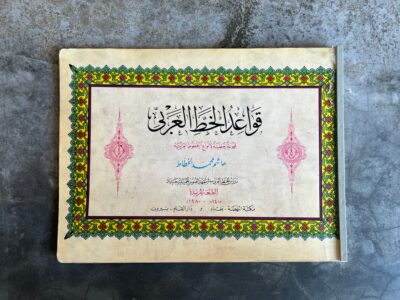
Wissam Shawkat’s calligraphy textbook – © emmy·in·the·mix
Despite the ongoing heavy bombing, the underground shelter with no electricity, and the lack of an official master to learn from, Wissam took his pens, his textbook and started practicing, developing a skill that ultimately opened the prestigious doors of Chopard, Hermès, and Montblanc.
Unexpected assignment
“As a teenager, I had a summer job in a sign shop, in the early 90s. I remember that one of the things I used to do was write a lot of gravestones for martyrs who died during the war. The carving used to be on marble, with masking tape on it. Then, we wrote with ink on the tape, cut it like a stencil and put acid. It would eat the marble in that area, then we removed the tape, painted it, and filled it up.”
Emerging as an artist
“I got my engineering degree in 1996 and that year, a businessman in Basra [Iraq] held a calligraphy exhibition with a prize. He said that he would buy the best 3 artworks, and I won 1 of those! He paid 20 dollars for it, which at the time with the sanctions, was a lot of money, it was the salary of a teacher! Then I went to the army, where calligraphy helped me to escape and survive. In 1998, I was invited to Bagdad 4th International Calligraphy exhibition: I displayed my work with colour and won an award. A reporter from Qatari Al Raya newspaper called me when I went back to my hometown: she was the first foreign person to interview me, I still have a copy! Then, her boss, the editor-in-chief, wanted to buy all my 3 artworks at 100 USD each. I became the talk of the city!
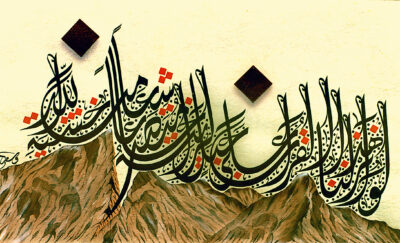
One of the artist’s works exhibited in Bagdad in 1998 – © Wissam Shawkat
That was the starting point to take my art profession seriously. In the early 2000s, I became known in Iraq. I was the only Christian calligrapher at the time, which made me stand out. The Sharjah Museum bought some artwork from me but was not able to send the money. In 2002, they invited me and I decided to go. My brother organised my visa, and I never went back.”
A turbulent script
When Wissam Shawkat was working at a design agency, a client request to design a 1-word logo gave birth to what is called “Al Wissam”, the artist’s own calligraphic style.
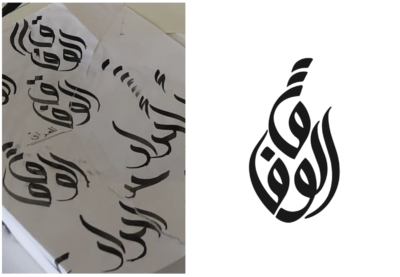
The artist’s original sketch for the 1-word logo (left), The final logo (right) – © Wissam Shawkat
“It’s a new style I created, one style from my work. I did many sketches, one stood out and I liked it. The project didn’t go through. I continued using it and people started liking this style. In 2010, I participated in a show at Dubai International Financial Centre, where the theme was “Bismillah” [editor’s note: meaning “in the name of God”]. For the first time, I wanted to write an art piece with my own script. It created quite a stir in the show! Half of the reactions were “it’s haram” [editor’s note: forbidden]. I started to wonder, is calligraphy art? Coming up with something new, very few people have done it. I believe we should not stop because that’s the way we get new styles. When social media came, in 2013, my style became popular. I don’t like the name, though, we need to change it!”

Bismillah (2010), as exposed at DIFC – © Wissam Shawkat
Staying true to oneself
“Are we doing art or are we copying? In my time, information was limited. Nowadays, not all available information is correct or true. Actually, 70% material available is wrong, and normal people can’t tell! I’m sure what I do is being influenced somehow. At the same time you have to stay true to yourself. My body of work has evolved gradually in one direction: I’ve been practicing calligraphy for 37 years now, I keep my old sketches! I don’t really have a favourite work, maybe “The Love Garden” in thuluth script: at the time, no one was turning letters around.”
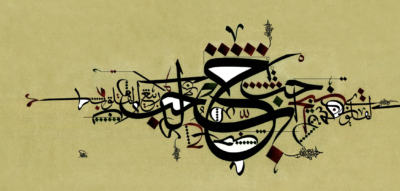
The Love Garden (2010) – © Wissam Shawkat
French touch
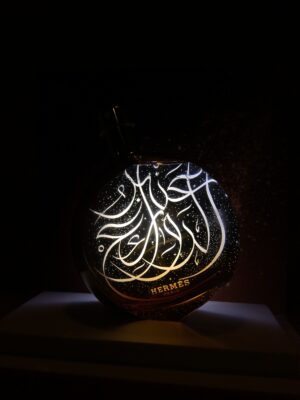
Ambre des Merveilles – © Wissam Shawkat
The artist collaborated with Hermès on the perfume “Eau des Merveilles”, turned “Ambre des Merveilles”, a limited edition for the Gulf countries.
“In 2013, when the perfume was released, I was contacted by Hermès. It was a very popular perfume and they wanted to write the Arabic name on it. The process of designing and approving the calligraphy was amazing, it is in “Al Wissam” style, but very thin.”
On “Calligraformism”
This new term was coined by the artist in December 2016, inspired by the way he experiments with letters, thereby creating a dialogue between western abstract art and the tradition of Arabic calligraphy.
“I was going to bed one day, my head was on the pillow, and the words calligraphy and form came to me. I went to my office, wrote it down, and posted it on Instagram the next day! When I was in New York, I went to museums and started researching art movements that pushed boundaries, especially, Cubism, futurism, and abstract expressionism. I started to design new pieces. By changing the thickness of my pen, I noticed that I get interesting shapes, still using classical script. I fill in the empty space as well. I’m influenced a lot by modern collage, by the dada movement. I’m not bringing free-form calligraphy; I’m bringing traditional script with the style of European culture.
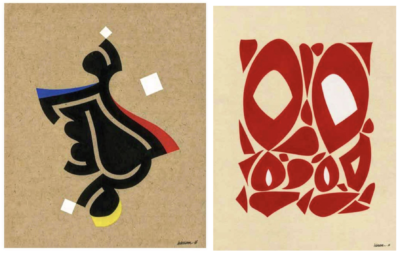
Bauhaus Dance, left – Through the Eyes of Letters, right (2022) – © Wissam Shawkat
In 2015, I decided to create a show. I talked to Tashkeel [editor’s note: a Dubai-based incubator for art], which agreed to host it, and I called it “Monumental 11/11”: that was the date I left Iraq. When big Turkish calligraphers came to see my show, they saw my abstract work and didn’t like it. But people who are educated in art, Europeans especially, loved it.”
Artistic crush
“I am inspired by Cecil Touchon, and I recently discovered Norman Ives. Picasso is really inspiring, I’ve seen almost all of his work. What he did is what I’m trying to do with my art: he is the man, along with George Braque! I like the Bauhaus movement too, it has a big influence on my Calligraforms.”
One last word
“Art is like planting seeds, it takes time to grow.”
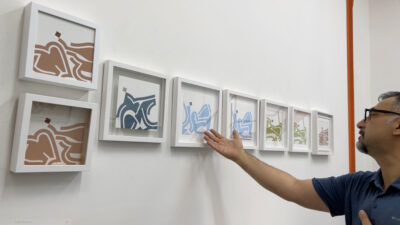
The artist showing me “Four Seasons” – © emmy·in·the·mix
This interview has been edited for length and clarity.
Cover picture: The artist showing me “Childhood Dreams 3” – © emmy·in·the·mix
Find out more Wissam Shawkat's Instagram account: https://www.instagram.com/wissamshawkat/ Watch the video interview: https://www.youtube.com/watch?v=bbAlAERbY8o 11 November - 31 December 2022: Letters of love II exhibition in Dubai https://alserkal.online/event/letters-of-love-ii https://en.vogue.me/culture/wissam-shawkat-arabic-calligrapher-interview/

